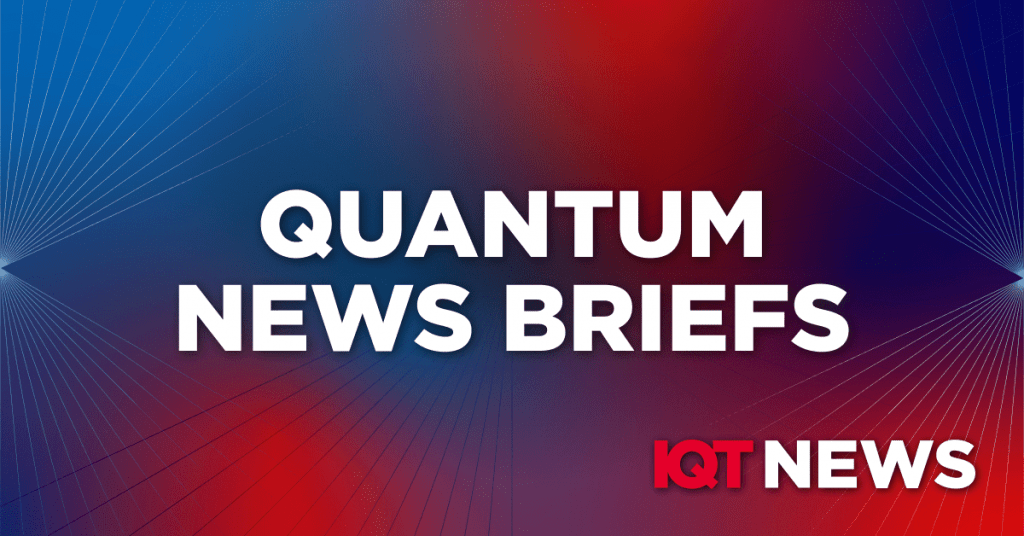News Briefs:
Classiq and QuEra announce integration of neutral-atom quantum computers into Classiq platform
With this collaboration, Classiq users will be able to exploit the distinctive features of QuEra’s neutral-atom quantum computers, such as the ability to simultaneously operate on multiple qubits and advanced qubit shuttling. Additionally, the integration provides access to Classiq’s extensive pre-written algorithmic blocks and allows customers to estimate the resources needed to run their algorithms. These capabilities enable the creation of highly resource-efficient algorithms with a large number of qubits and, in the future, for logical qubits as well.
In Other News:
Meritalk reports “CISA details PQC migration roadmap, plans to release ‘very soon’
Meritalk’s Cate Burgann explained that The Cybersecurity and Infrastructure Security Agency (CISA) is gearing up to release its post-quantum cryptography (PQC) migration roadmap soon in her recent article.
In 2022, the Office of Management and Budget (OMB) released a memorandum (M-23-02) that directed agencies to create an inventory of their most critical cryptographic systems.
CISA’s PQC migration roadmap will help guide Federal agencies on what to do next, the agency’s Associate Chief of Strategic Technology Gary Jones said.
The roadmap’s timeline for implementation starts in quarter two of fiscal year (FY) 2024 and ends in FY 2035.
“We anticipate that vendors will start to incorporate this in the next year after the standards are released,” Jones said.
Some of the activities don’t have specific deadlines, but rather are continuous over the next ten years – like monitoring systems for compliance.
“The end is FY35,” Jones said. “It really won’t be the end, but that’s when it’s been mandated that we migrate to PQC.”
In Other News from Uof Chicago: “New method could yield fast, cross-country quantum network”
Researchers at the University of Chicago Pritzker School of Molecular Engineering (PME) have proposed a new approach to the quantum internet, — building long quantum channels using vacuum sealed tubes with an array of spaced-out lenses, according to article by Sarah Williams on the University of Chicago’s website. These vacuum beam guides, about 20 centimeters in diameter, would have ranges of thousands of kilometers and capacities of 10 trillion qubits per second, better than any existing quantum communication approach. Photons of light encoding quantum data would move through the vacuum tubes and remain focused thanks to the lenses.
“We believe this kind of network is feasible and has a lot of potential,” said Liang Jiang, professor of molecular engineering and senior author of the new work. “It could not only be used for secure communication, but also for building distributed quantum computing networks, distributed quantum sensing technologies, new kinds of telescopes, and synchronized clocks.”
Jiang collaborated with scientists at Stanford University and the California Institute of Technology on the new work
In Other News: Power Discusses “A blueprint for quantum-safe utility communications”
Ken Rabedeau discusses the rapid evolution of quantum computing in his rand explains why a cryptographically relevant quantum computer (CRQC) that can benefit utilities but will also potentially benefit the bad actors.
While utilities may not have to deal with a quantum attack for some time, they’re already facing a serious quantum threat. Bad actors could use fiber-tapping techniques with advanced storage technologies to harvest huge amounts of encrypted data on grid assets, systems, and operations. When they gain access to a CRQC, they will be able to decrypt this data and use it to compromise the utility assets they identify. These harvest now, decrypt later (HNDL) threats could have major consequences for utilities and their customers. Successful decryption would allow threat actors to analyze asset communications, so they can use a MITM attack to disrupt critical inter-asset communications or even take control of assets. They could spoof commands to manipulate critical intelligent electronic devices (IEDs) or overwhelm core asset management servers with DoS attacks. Government agencies recognize this threat and are urging critical industries to address it. Utilities can’t play a waiting game with HNDL attacks—quantum-safe networks need to be considered and built now.
